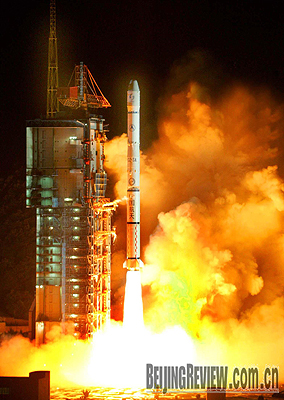|

FIRE AND SMOKE: The 100th Long March launch vehicle takes off on June 1, 2007, carrying the SinoSat 3 (Xinnuo 3) communications satellite into orbit. Since 1970, Long March rockets have carried out 107 space missions
China has taken an important step forward in developing its next-generation carrier rocket with large payload, Long March 5, which is scheduled for operation by 2014, according to a Xinhua News Agency report that cited sources at the country's launch vehicle academy.
Significant progress has been made on improving the rocket engine and on building a production plant. The rocket's 120-ton liquid oxygen-kerosene engine has passed initial tests and will be put into field tests by the end of next year, said Liang Xiaohong, Vice President of the China Academy of Launch Vehicle Technology.
Long March 5 rockets will meet the requirement of low earth orbit (LEO) and geosynchronous transfer orbit (GEO) missions for the next two to three decades, according to Li Hong, President of the launch vehicle academy.
The 59.5-meter long rocket will weigh 643 tons with its four boosters and will be capable of delivering a 25-ton payload to an LEO, compared with the present 10 tons, and a 14-ton payload to a GEO, compared with 5.5 tons now.
The 14-ton payload to a GEO means the rocket can carry a heavier satellite or more satellites at one time while the 25-ton payload to an LEO will enable it to carry Shenzhou spaceships, said Li Dong, one of Long March 5 rocket designers.
| 